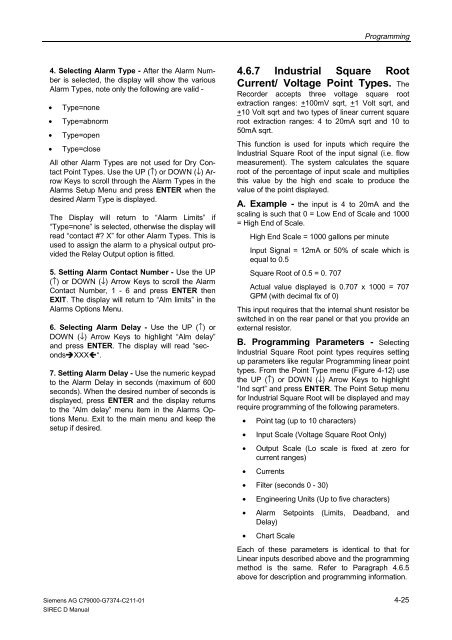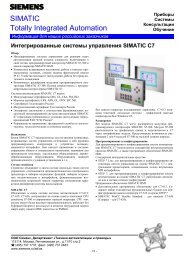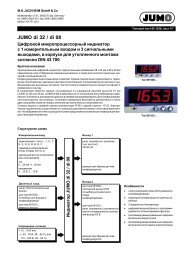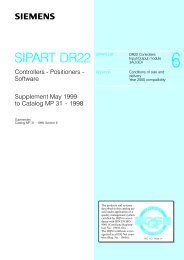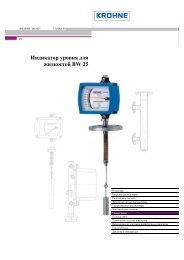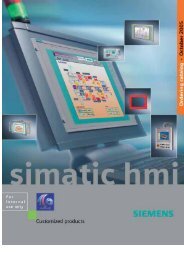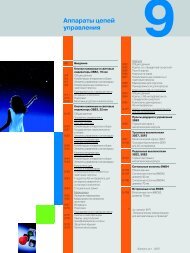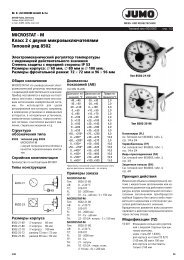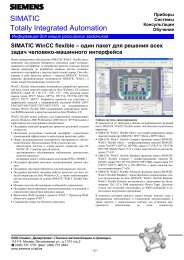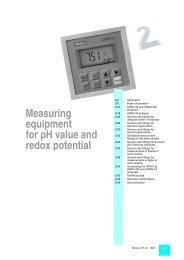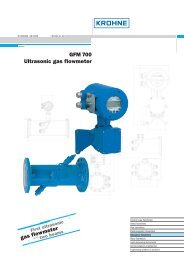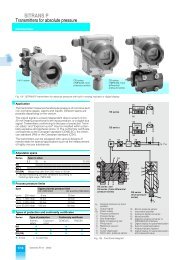SIREC D Display Recorder 7ND4000
SIREC D Display Recorder 7ND4000
SIREC D Display Recorder 7ND4000
Erfolgreiche ePaper selbst erstellen
Machen Sie aus Ihren PDF Publikationen ein blätterbares Flipbook mit unserer einzigartigen Google optimierten e-Paper Software.
4. Selecting Alarm Type - After the Alarm Number<br />
is selected, the display will show the various<br />
Alarm Types, note only the following are valid -<br />
• Type=none<br />
• Type=abnorm<br />
• Type=open<br />
• Type=close<br />
All other Alarm Types are not used for Dry Contact<br />
Point Types. Use the UP (↑) or DOWN (↓) Arrow<br />
Keys to scroll through the Alarm Types in the<br />
Alarms Setup Menu and press ENTER when the<br />
desired Alarm Type is displayed.<br />
The <strong>Display</strong> will return to “Alarm Limits” if<br />
“Type=none” is selected, otherwise the display will<br />
read “contact #? X” for other Alarm Types. This is<br />
used to assign the alarm to a physical output provided<br />
the Relay Output option is fitted.<br />
5. Setting Alarm Contact Number - Use the UP<br />
(↑) or DOWN (↓) Arrow Keys to scroll the Alarm<br />
Contact Number, 1 - 6 and press ENTER then<br />
EXIT. The display will return to “Alm limits” in the<br />
Alarms Options Menu.<br />
6. Selecting Alarm Delay - Use the UP (↑) or<br />
DOWN (↓) Arrow Keys to highlight “Alm delay”<br />
and press ENTER. The display will read “seconds�XXX�“.<br />
7. Setting Alarm Delay - Use the numeric keypad<br />
to the Alarm Delay in seconds (maximum of 600<br />
seconds). When the desired number of seconds is<br />
displayed, press ENTER and the display returns<br />
to the “Alm delay” menu item in the Alarms Options<br />
Menu. Exit to the main menu and keep the<br />
setup if desired.<br />
Siemens AG C79000-G7374-C211-01<br />
<strong>SIREC</strong> D Manual<br />
Programming<br />
4.6.7 Industrial Square Root<br />
Current/ Voltage Point Types. The<br />
<strong>Recorder</strong> accepts three voltage square root<br />
extraction ranges: +100mV sqrt, +1 Volt sqrt, and<br />
+10 Volt sqrt and two types of linear current square<br />
root extraction ranges: 4 to 20mA sqrt and 10 to<br />
50mA sqrt.<br />
This function is used for inputs which require the<br />
Industrial Square Root of the input signal (i.e. flow<br />
measurement). The system calculates the square<br />
root of the percentage of input scale and multiplies<br />
this value by the high end scale to produce the<br />
value of the point displayed.<br />
A. Example - the input is 4 to 20mA and the<br />
scaling is such that 0 = Low End of Scale and 1000<br />
= High End of Scale.<br />
High End Scale = 1000 gallons per minute<br />
Input Signal = 12mA or 50% of scale which is<br />
equal to 0.5<br />
Square Root of 0.5 = 0. 707<br />
Actual value displayed is 0.707 x 1000 = 707<br />
GPM (with decimal fix of 0)<br />
This input requires that the internal shunt resistor be<br />
switched in on the rear panel or that you provide an<br />
external resistor.<br />
B. Programming Parameters - Selecting<br />
Industrial Square Root point types requires setting<br />
up parameters like regular Programming linear point<br />
types. From the Point Type menu (Figure 4-12) use<br />
the UP (↑) or DOWN (↓) Arrow Keys to highlight<br />
“Ind sqrt” and press ENTER. The Point Setup menu<br />
for Industrial Square Root will be displayed and may<br />
require programming of the following parameters.<br />
• Point tag (up to 10 characters)<br />
• Input Scale (Voltage Square Root Only)<br />
• Output Scale (Lo scale is fixed at zero for<br />
current ranges)<br />
• Currents<br />
• Filter (seconds 0 - 30)<br />
• Engineering Units (Up to five characters)<br />
• Alarm Setpoints (Limits, Deadband, and<br />
Delay)<br />
• Chart Scale<br />
Each of these parameters is identical to that for<br />
Linear inputs described above and the programming<br />
method is the same. Refer to Paragraph 4.6.5<br />
above for description and programming information.<br />
4-25


